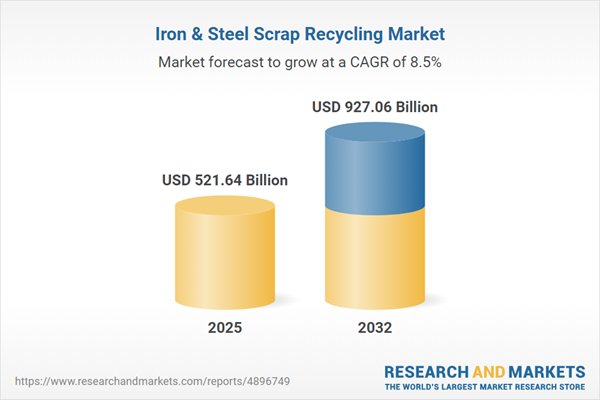Speak directly to the analyst to clarify any post sales queries you may have.
The iron and steel scrap recycling market is undergoing significant transformation as industrial organizations prioritize sustainability and seek operational advantages. Senior decision-makers navigating this landscape require clarity on evolving regulations, technological trends, and market dynamics to inform strategy and maintain competitiveness.
Market Snapshot: Iron and Steel Scrap Recycling Market Growth and Dynamics
The iron and steel scrap recycling market increased from USD 481.23 billion in 2024 to USD 521.64 billion in 2025, and it is expected to reach USD 927.06 billion by 2032 with a CAGR of 8.54%. Stronger regulatory frameworks and sustained demand are accelerating this expansion. Major impacts are driven by investments in advanced processing, enhanced transparency in material quality, and vertical integration across the industry. Both established and new market participants are focusing on improving operational efficiency and securing reliable sourcing to address emerging sector needs and evolving client expectations.
Scope & Segmentation of the Iron and Steel Scrap Recycling Market
This report offers comprehensive segmentation to support targeted strategic planning and resource optimization across the iron and steel scrap recycling value chain:
- Scrap Types: Includes cast iron scrap, heavy melting steel (HMS), manganese steel scrap, old car bodies, and shredded scrap, each relevant for varied quality standards in multiple sectors.
- Recycling Methods: Details baling, melting, shearing, and shredding, reflecting the importance of maximizing recovery rates and maintaining material purity in each process.
- Source of Generation: Reviews origin points such as automotive, construction and demolition, electrical and electronics, household appliances, and industrial sources to help optimize scrap collection strategies.
- Grade: Differentiates home scrap, obsolete scrap, and prompt scrap to support quality assurance and facilitate custom service solutions.
- End-Use Industries: Covers automotive, construction, equipment manufacturing, shipbuilding, and steel production, illustrating unique drivers, constraints, and opportunities for each sector.
- Regions: Considers North America, Latin America, Europe, Middle East, Africa, and Asia-Pacific, analyzing the regulatory environments, infrastructure development, and logistics influencing local and global growth opportunities.
- Featured Companies: Profiles major entities such as European Metal Recycling Limited, Sims Limited, Schnitzer Steel Industries, Inc., SA Recycling LLC, Kuusakoski Oy, Commercial Metals Company, Steel Dynamics, Inc., China Metal Recycling (Holdings) Limited, Veolia Environnement S.A., and Mitsubishi Materials Corporation to strengthen peer benchmarking and industry insight.
Key Takeaways for Market Leaders
- Scrap recycling enables steelmakers to meet tightening environmental and efficiency standards, ensuring relevance amid evolving compliance requirements.
- Digitized traceability tools and advanced quality control systems improve transparency and secure reliable sourcing for both recyclers and secondary users.
- Distinct sector requirements call for tailored processing—such as disassembling automotive components or handling demolition waste—to maximize recovery and maintain consistency.
- Vertical integration and collaborative initiatives reinforce supply chain stability, reducing exposure to price variability and helping manage logistical disruptions.
- Widespread adoption of robotics and AI-driven identification supports market leadership, especially as both mature and emerging regions innovate amidst mounting competition.
- Regional policy incentives and infrastructure readiness require market strategies to be responsive to local characteristics for continued resilient growth.
Tariff Impact: Navigating Policy-Driven Disruptions
The introduction of US tariffs on iron and steel scrap in 2025 has triggered greater cost uncertainty and necessitated adaptation throughout the global market. Industry players are reconfiguring shipment flows, developing tariff-exempt logistics channels, and expanding value-added processing operations in international locations to retain competitiveness. Domestic stakeholders in affected regions are reinforcing supplier relationships and investing in reliable scrap recovery networks while engaging in regulatory advocacy to keep pace with shifting global trade practices.
Methodology & Data Sources
Our research approach integrates primary interviews with facility managers, steel producers, logistics professionals, and regulatory bodies. Secondary research, including reviews of industry publications, technical reports, trade association intelligence, and government statistics, enhances objectivity and provides a solid platform for analysis.
Why This Report Matters for Senior Decision-Makers
- Equips leaders with clear market segmentation and trend analysis to inform strategic investment and competitive positioning.
- Supports organizations through benchmarking and technology roadmaps that address ongoing changes in regulation and market demand.
- Delivers tactical recommendations designed to build resilient supply chains, streamline operations, and promote sustainable value in alignment with policy and industry goals.
Conclusion
Adapting strategies to the evolving iron and steel scrap recycling market will support enduring competitiveness and sustainable growth. Senior decision-makers can leverage this report to guide informed, responsible advancement through complex market challenges.
Additional Product Information:
- Purchase of this report includes 1 year online access with quarterly updates.
- This report can be updated on request. Please contact our Customer Experience team using the Ask a Question widget on our website.
Table of Contents
3. Executive Summary
4. Market Overview
7. Cumulative Impact of Artificial Intelligence 2025
List of Figures
Samples

LOADING...
Companies Mentioned
The key companies profiled in this Iron & Steel Scrap Recycling market report include:- European Metal Recycling Limited
- Sims Limited
- Schnitzer Steel Industries, Inc.
- SA Recycling LLC
- Kuusakoski Oy
- Commercial Metals Company
- Steel Dynamics, Inc.
- China Metal Recycling (Holdings) Limited
- Veolia Environnement S.A.
- Mitsubishi Materials Corporation
Table Information
| Report Attribute | Details |
|---|---|
| No. of Pages | 185 |
| Published | October 2025 |
| Forecast Period | 2025 - 2032 |
| Estimated Market Value ( USD | $ 521.64 Billion |
| Forecasted Market Value ( USD | $ 927.06 Billion |
| Compound Annual Growth Rate | 8.5% |
| Regions Covered | Global |
| No. of Companies Mentioned | 11 |









